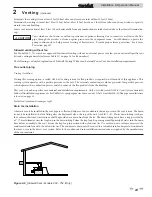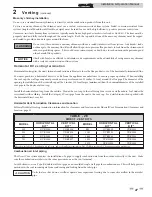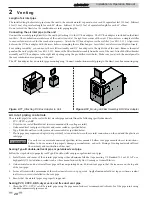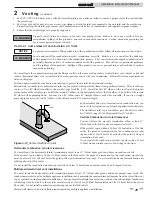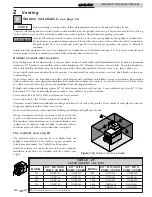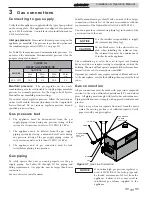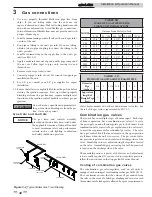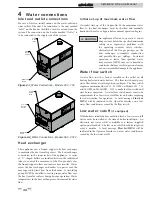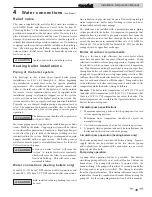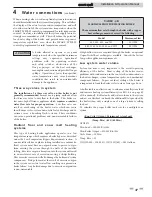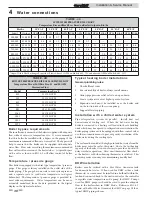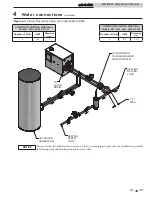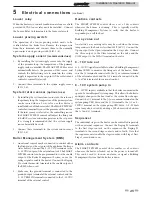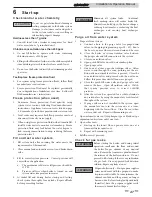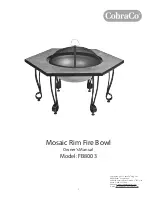
36
Installation & Service Manual
4
Water connections
CAUTION
At no time should the system pressure be less
than 12 PSIG.
Pump Maintenance:
Inspect the pump every six (6) months
and oil as necessary. Use SAE 30 non-detergent oil or lubricant
specified by the pump manufacturer.
The boiler is recommended for installation in a primary/
secondary piping system.
This type of system uses a separate
boiler circulating pump to supply flow to and from the boiler
only. The secondary pump is sized based on the head loss of the
boiler and related pipe and fittings in the secondary loop only.
A properly sized primary system pump provides adequate
flow to carry the heated boiler water to radiation, air over
coils, etc. The fittings that connect the boiler to the primary
system should be installed a maximum of 12 inches (0.30m)
(or 4 pipe diameters) apart to ensure connection at a point of
zero pressure drop in the primary system. There should be a
minimum of 10 pipe diameters of straight pipe before and after
the boiler secondary loop connections to prevent turbulent
flow at the secondary loop connections. The secondary loop
piping to and from the boiler must have a fully ported ball valve
installed in both the supply and return side piping. The ball
valves must be fully ported having the same inside diameter as
the installed piping. The ball valve in the piping supplying water
to the boiler will only be used as a service valve. The ball valve
installed in the discharge from the boiler back to the primary
system will be used to adjust boiler flow and temperature rise to
ensure proper performance.
The boiler primary piping system must have a circulator
installed in the main system loop to carry the heated boiler
water to the point of use in the main system.
Multiple boilers may also be installed with a primary/secondary
manifold system. Multiple boilers should be connected to the
common manifold in reverse return to assist in balancing flow
to multiple boilers.
The installer must ensure that the boiler has adequate flow
without excessive temperature rise. Low system flow can result
in overheating of the boiler water which can cause short burner
cycles, system noise, relief valve discharge and in extreme cases,
a knocking flash to steam. These conditions indicate the need
to increase boiler flow to and from the boiler. This is generally
accomplished by either increasing the size of the boiler pump or
by increasing the diameter of the piping that connects the boiler
to the primary system. A larger diameter pipe reduces head loss
and increases flow.
Low Temperature Return Water Systems
Any non-condensing boiler will develop operational problems
when exposed to inlet water temperatures below 140°F.
Lochinvar offers a low temperature protection valve (LTV)
that is factory preset to maintain 140°F inlet water to the boiler
regardless of the system return water temperature. See Table 4A
for available valve kits.
TABLE 4A
LTV VALVE KITS
MODEL
LTV VALVE KIT
402 - 752
VAL3048
992 - 2072
VAL3047
For Example:
Night Setback
of the system loop water
temperature,
Night Shutdown
and
Weekend Shutdown
of the
entire boiler / heating system, and Indoor / Outdoor Air Reset
of the system loop water temperature. If any of these control
functions are being utilized, some type of low return water
protection
MUST BE
provided.
If the boiler heating system will be used on a Water Source Heat
Pump System, Radiant Floor Heating System, Snow Melting
Heating System, etc., some type of low return water protection
must be provided.
Condensation can cause operational problems, bad combustion,
sooting, flue gas spillage and reduced service life of the vent
system and related components.
To prevent system return water temperature below 140°F
(60°C) from entering the boiler inlet, an electrically actuated
3-way mixing valve is available, consult manufacturer for kit
availability (see FIG. 4-5 on page 41). By using this valve, the
SMART SYSTEM control will bypass outlet water back into the
inlet of the boiler to maintain the inlet temperature above 140°F
(60°C).
A fast acting, self contained mixing valve, set to 140°F (60°C),
may also be used. The installation of this valve must be done as
shown in FIG. 4-5. This arrangement will maintain the required
flow through the boiler.
Low temperature bypass requirements
To prevent condensation problems, a boiler MUST NOT be
operated (other than for brief periods during initial system
startup) with an inlet water temperature of less than 140°F
(60°C). If normal system return temperatures are less than the
required 140°F (60°C) boiler inlet requirement, a method of
low return water temperature protection
MUST BE
provided
to protect the boiler.
Minimum boiler water temperatures
Inlet water temperatures below the specified minimum of
140°F (60°C) can excessively cool the products of combustion
resulting in condensation on the heat exchanger. Condensation
on the heat exchanger can cause operational problems, bad
combustion, sooting, flue gas spillage and reduced service life
of the related components. See the Low Temperature Bypass
Requirements section for boiler system applications below the
minimum specified temperature.


